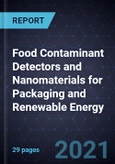DNA-based Sensors for Detecting Food Adulterants, Graphene-based Rapid Electrochemical Biosensors
This issue of the Nanotechnology Opportunity Engine (TOE) covers growth opportunities in food contaminant detectors and nanomaterials for packaging and renewable energy. The TOE primarily focuses on sensors for varied applications, such as DNA-based sensors for detecting food adulterants, graphene-based rapid electrochemical biosensors, paper-based electrical gas sensors for monitoring food freshness, and carbon nanotube-based nanosensors for pathogen detection.
The TOE profiles healthcare applications, such as mixed metal oxide nanoparticles for tissue regeneration and a patch that reduces the risk of infections during wound healing. The TOE also covers water purification technologies such as, a graphene oxide-manganese dioxide nanocomposite-based nanofilter for removing organic dyes from wastewater and a graphene membrane for water desalination. The TOE also throws light on enhancing solar energy technology with hybrid materials.
The Nanotechnology Opportunity Engine provides intelligence on technologies, products, processes, applications, and strategic insights on nanotechnology-related innovations and their impact across various industries. Technology focus areas include nanocatalysts, antimicrobials, nanocellulose, and nanoplatelets.
The Chemicals and Advanced Materials cluster tracks research and innovation trends and developments across specialty chemicals, plastics, polymers, chemicals, bio-chemicals, metals, coatings, thinfilms, surface treatments, composites, alloys, oil and gas, fuel additives, fibers, and several other related technologies and its impact and application across industries.
Table of Contents
1. Technology Advances in Nanosensors, Nanoparticles, and Anti-Corrosion Technologies
- DNA-based Sensor for Detecting Food Adulterants
- Rapid, On-Site Qualitative Detection Kit With Colorimetric Readout
- SwissDeCode - Investor Dashboard
- Graphene-based Rapid Electrochemical Biosensor
- Highly Sensitive, Nanostructured Biosensor for Detecting Food Pathogens
- NanoSpy - Investor Dashboard
- Paper-based Electrical Gas Sensor for Monitoring Food Freshness
- Cost-Effective, Paper-based Sensor Label Monitors Freshness of Protein-Rich Packaged Foods
- BlakBear - Investor Dashboard
- Carbon Nanotube-based Nanosensor for Pathogen Detection
- Fast Response Pathogen Detecting Nanosensors With Healthcare, Food, and Environmental Safety Applications
- IdentifySensors - Investor Dashboard
- Mixed Metal Oxide Nanoparticles for Tissue Regeneration
- Use of Metal Oxide in Nanoparticle Paste Offers a Cost Advantage Over the Existing Bio-Engineered Wound Healing Solutions
- Anavo Medical - Investor Dashboard
- Corrosion Protection Technology for Metal Packaging
- Developing Highly Efficient Graphene Nanopore Membrane
- Cost-Efficient Alternative for Removing Organic Dyes from Wastewater
- Enhancing Solar Energy Technology With Hybrid Materials
- Reducing the Risk of Infection During Wound Healing
2. Key Contacts
Companies Mentioned (Partial List)
A selection of companies mentioned in this report includes, but is not limited to:
- Anavo Medical
- BlakBear
- IdentifySensor
- NanoSpy
- SwissDeCode








